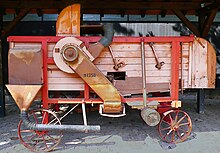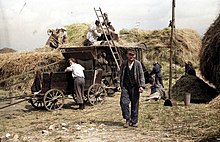thresher




A threshing machine , also known as a threshing box , is an agricultural device for threshing grains, especially grain. Threshing machines are no longer in use in the professional sector today; they were replaced by combine harvesters in Germany between the 1950s and 1960s . There were stationary and mobile threshing machines. The threshing machines were initially driven by horse pegs or steam engines , later mostly by electric motors , stationary combustion engines or tractors . But there were also small threshing machines for manual operation.
history
- 1786: The Scottish mechanical engineer Andrew Meikle builds the first usable threshing machine (blow bar thresher), possibly on the basis of earlier designs.
- 1797: Pastor Benjamin Georg Peßler develops a mechanical threshing machine in Wedtlenstedt near Braunschweig .
- 1831: The American Samuel Turner invents the pen thresher.
- 1834: The American Pitt brothers build for the first time a machine in which threshing and grain cleaning take place.
- 1851: The world exhibition in London shows the new "farm tools", including the new steam threshing machines that have since found their way into Germany.
As a result, the grain threshing can be done in a few weeks. Previously, the grain harvest had been threshed with the flail , which took about 30 weeks from late September to early May. The farm day laborers received part of the threshed grain from the threshing and had a permanent job through the winter. Likewise were threshing used. With the threshing machine they become unemployed or underemployed in winter and have to accept lower wages for other jobs.
- In 1929 the Stahl-Lanz manufactured by Heinrich Lanz AG is presented: the first threshing machine in all-steel construction.
A problem in the development of the threshing machine was initially the high speed of the threshing drum / drum, which was necessary for proper work, since until around 1850 people were reluctant to go beyond the critical speed of the drum at which natural vibrations occur. Drum speeds of approx. 1000 rpm are required for perfect threshing.
In Germany , threshing machines were most widespread in the first half of the 20th century. There were around 650,000 threshing machines in Germany. After the grain harvest in autumn and well into winter, contractors with locomotives or tractors (which were then also used as a drive) and threshing machines moved from village to village to thresh the farmers' grain. Alternatively, the threshing machines were purchased jointly by the local farmers. The rest of the year the machine was parked in the threshing machine store.
Working method
The ears , pods , capsules , etc. are ginned between a high-speed drum and a stationary basket that partially encloses the drum by impact or friction.
One distinguishes between:
- Blow bar thresher and
- Pen thresher
In the case of blow bar threshers, the drum circumference is provided with ribbed strips along the side and the basket with smooth, sharp-edged strips. The grain is knocked out of the ears through the strips on the threshing drum. Since the sheaves are laid in parallel to the drum, the flail thresher is also known as a wide thresher. This technique is still used in today's combine harvesters.
With pin threshers, the pins of the drum run between the pins of the basket. The distance between the basket is adjustable. The pen thresher worked more effectively, but damaged the grain more. In addition, the straw is severely kinked and torn, which prevents it from being used for any other purpose except for fodder and litter purposes, for example in paper and cardboard manufacture. Since the sheaves are fed into the drum at a right angle , the pin thresher is also called a long thresher.
What both types of threshing machine have in common is that the grains are separated from straw , litter and waste using so-called shakers, sieves and fans . 20th century machines were also equipped with a straw press and bag lifter. Long straw, short straw, sand and weeds left the threshing machine in a separate way, while the grains were bagged after removing the awns and cleaning and sometimes sorting them.
Special devices were also manufactured for oil fruits, pulses and corn.
A village community often used a single threshing machine that was rented to the farmer who was harvesting . At harvest time it was then in constant use. For loading the threshing machine with sheaves, sagging the grain, removing and loading the threshed straw, etc., around 10 people were required. Franz Rehbein describes in detail the threshing practice with a steam threshing machine around 1900 in The Life of a Farm Worker.
Individual evidence
- ^ Benjamin Georg Peßler : Description and illustration of a new threshing machine . Braunschweig 1797 ( digitized version , Bavarian State Library ).
- ↑ Schweigmann, as named after in literature.
- ^ Gerhardt Preuschen , Arable farming according to ecological laws, 2nd edition, 1991/1994, Verlag CF Müller, Heidelberg, ISBN 3-7880-9873-2 , p. 251
- ^ Gustav Fischer: Agricultural engineering . Ulmer, Stuttgart 1928, reprint by Weltbild, Augsburg 2005, ISBN 3-8289-5400-6 , p. 389 f.
literature
- Paul Schweigmann: Agricultural machines and their maintenance: a comprehensive manual and reference book of agricultural machinery practice for repair workshops, agricultural machinery dealers and all those involved in agriculture, with 20 tables and an appendix: Technical data for agricultural tractors. , Specialist book publisher Dr. Pfanneberg , Gießen, 1955, reprinted by Bulldog Press, Limburg an der Lahn, 1993, ISBN 3-9803332-1-3 , page 245 ff.






